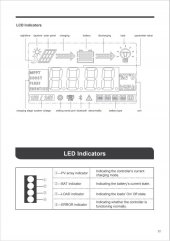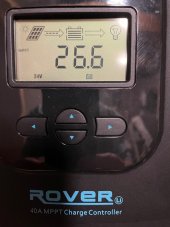I have a Renogy Rover 40 amp mppt charger. In the manual under what the PV indicator lights mean, it says that if a White Slow Flashing is occurring it means the controller is undergoing boost stage. Below that it says a White Single Flashing means the Controller is undergoing float stage. Say what? How many seconds are we talking about. My unit is flashing once every 2 seconds, so am I to assume it means I am in float stage? How long is Slow Flashing anyway. Thank you for any thoughts.
You are using an out of date browser. It may not display this or other websites correctly.
You should upgrade or use an alternative browser.
You should upgrade or use an alternative browser.
Flashing lights
- Thread starter lightmail
- Start date
BentleyJ
Solar Wizard
It would be nice if they gave a bit more details. Based on what I've seen with blinking LED's on HVAC equipment used for diagnostic trouble codes. Your assessment sounds correct. The 2 seconds is the pause and the blink is the single flash so float stage. Where as if the LED were flashing with an approx equal On/Off duty cycle like 500ms on 500ms off then that would be a slow flash.
It would be nice if they gave a bit more details. Based on what I've seen with blinking LED's on HVAC equipment used for diagnostic trouble codes. Your assessment sounds correct. The 2 seconds is the pause and the blink is the single flash so float stage. Where as if the LED were flashing with an approx equal On/Off duty cycle like 500ms on 500ms off then that would be a slow flash.
How is a 500ms on and 500ms off considered slow, please explain, because that seems fast.It would be nice if they gave a bit more details. Based on what I've seen with blinking LED's on HVAC equipment used for diagnostic trouble codes. Your assessment sounds correct. The 2 seconds is the pause and the blink is the single flash so float stage. Where as if the LED were flashing with an approx equal On/Off duty cycle like 500ms on 500ms off then that would be a slow flash.
How is a 500ms on and 500ms off considered slow, please explain, because that seems fast.
The best way to know what mode the Renogy Rover 40 amp SCC is in is to look at the Main Page Display using the up/dn arrow keys. See attached pictures.
One picture shows the Rover 40 Main Page Display in MPPT Mode and the other is page 22 of the manual. In the picture with the Rover in MPPT mode the PV Array Indicator LED (not shown in picture) is solid. With Rover 40 in Boost the LED will flash on/off steady. With Rover 40 in Float the LED will quick flash on and then off.
Again the best way to know what mode the Rover 40 is operating is to look at the Main Page Display. Notice in the attached picture of page 22 of the manual it list the modes that the Rover 40 can display.
If using the Rover USER battery settings:
When the day starts in the morning the Rover will enter MPPT mode and stay there until Boost Charge Volt(V) is obtained. The Rover will stay at Boost voltage for the Boost Charge Time(Min) setting. After Boost Charge Time has completed the Rover will go to Float Charge Volt(V) and stay at this voltage as long as there is enough sunlight. If clouds build or if the sun starts to go down the Rover will re-enter MPPT mode at the Boost Char Return Volt(V). When night arrives the Rover will go into nighttime mode with moon icon and will not charge the battery. When morning comes the cycle repeats.
Note: The Rover should stay in MPPT mode if the battery voltage does not reach Boost Charge Volt.
Look at this post for more Renogy Rover information.

Renogy 40a mppt Li settings
Thanks for the info, I get no heat from the 2 awg wire so that's good for me. Just ordered a 40a circuit breaker to go between the charge controller and batteries plus the Blue Sea 5191 terminal block and 200a fuse today. The 8 guage is less than 2 feet and I did find a little heat when the...
Attachments
Thank you very much for your response. My main problem was I couldn't see the screen. My friend had built a seat in that area. So I could not get a direct view of the screen. But with a little Work I was able to see the screen with a magnifying glass and on an angle. And then I saw what you meant. It actually shows the mode it's in. All this time I have been concentrating on the flashing lights when it was right there in the words on the screen .
#1 Question Why do we put 14 as equalization charge if it's set for 0 equalization time? Can we set the equalization charge to zero as well?
#2 You mentioned that Equalization Charge Interval should be set at 185 to stop boost mode but how does it effect boost mode when Equalization is off? Thanks...
#1 Question Why do we put 14 as equalization charge if it's set for 0 equalization time? Can we set the equalization charge to zero as well?
#2 You mentioned that Equalization Charge Interval should be set at 185 to stop boost mode but how does it effect boost mode when Equalization is off? Thanks...
Thank you very much for your response. My main problem was I couldn't see the screen. My friend had built a seat in that area. So I could not get a direct view of the screen. But with a little Work I was able to see the screen with a magnifying glass and on an angle. And then I saw what you meant. It actually shows the mode it's in. All this time I have been concentrating on the flashing lights when it was right there in the words on the screen .The best way to know what mode the Renogy Rover 40 amp SCC is in is to look at the Main Page Display using the up/dn arrow keys. See attached pictures.
One picture shows the Rover 40 Main Page Display in MPPT Mode and the other is page 22 of the manual. In the picture with the Rover in MPPT mode the PV Array Indicator LED (not shown in picture) is solid. With Rover 40 in Boost the LED will flash on/off steady. With Rover 40 in Float the LED will quick flash on and then off.
Again the best way to know what mode the Rover 40 is operating is to look at the Main Page Display. Notice in the attached picture of page 22 of the manual it list the modes that the Rover 40 can display.
If using the Rover USER battery settings:
When the day starts in the morning the Rover will enter MPPT mode and stay there until Boost Charge Volt(V) is obtained. The Rover will stay at Boost voltage for the Boost Charge Time(Min) setting. After Boost Charge Time has completed the Rover will go to Float Charge Volt(V) and stay at this voltage as long as there is enough sunlight. If clouds build or if the sun starts to go down the Rover will re-enter MPPT mode at the Boost Char Return Volt(V). When night arrives the Rover will go into nighttime mode with moon icon and will not charge the battery. When morning comes the cycle repeats.
Note: The Rover should stay in MPPT mode if the battery voltage does not reach Boost Charge Volt.
Look at this post for more Renogy Rover information.

Renogy 40a mppt Li settings
Thanks for the info, I get no heat from the 2 awg wire so that's good for me. Just ordered a 40a circuit breaker to go between the charge controller and batteries plus the Blue Sea 5191 terminal block and 200a fuse today. The 8 guage is less than 2 feet and I did find a little heat when the...diysolarforum.com
#1 Question Why do we put 14 as equalization charge if it's set for 0 equalization time? Can we set the equalization charge to zero as well?
#2 You mentioned that Equalization Charge Interval should be set at 185 to stop boost mode but how does it effect boost mode when Equalization is off? Thanks...
Thank you very much for your response. My main problem was I couldn't see the screen. My friend had built a seat in that area. So I could not get a direct view of the screen. But with a little Work I was able to see the screen with a magnifying glass and on an angle. And then I saw what you meant. It actually shows the mode it's in. All this time I have been concentrating on the flashing lights when it was right there in the words on the screen .
#1 Question Why do we put 14 as equalization charge if it's set for 0 equalization time? Can we set the equalization charge to zero as well?
#2 You mentioned that Equalization Charge Interval should be set at 185 to stop boost mode but how does it effect boost mode when Equalization is off? Thanks...
Equalize Charge Volt(V) 14
Voltage to equalize lead acid batteries. When using Lifepo4 set same as boost charge volt.
It is probably best to set Equalize Charge Volt to the same as boost voltage. Setting to 0 would cause problems in the Rovers software code because in the manual it states the range is 9 to 17. Equalize will not happen because of the setting Equalize Charge Time(Min) 0.
The Equalization Charge Interval should be set at 185 so that the Rover will not get stuck in boost. If the value is set to 0 the Rover will never leave boost mode (stuck in boost). It appears to be a bug in the Rover software code. The Rover should transition to float after Boost Charge Time(Min) 10, but will not if Equalize Charge Interval(Days) is set to 0. At least that has been my experience. It is possible this will not happen with your system, but it does with both of my Rovers.
Equalize Charge Interval(Days) 185 (Must not be zero or Rover will stay in boost mode and never transition to float)
Number of days between equalizing lead acid batteries. Not used for Lifepo4
Similar threads
- Replies
- 2
- Views
- 283
- Replies
- 3
- Views
- 400
- Replies
- 9
- Views
- 332




